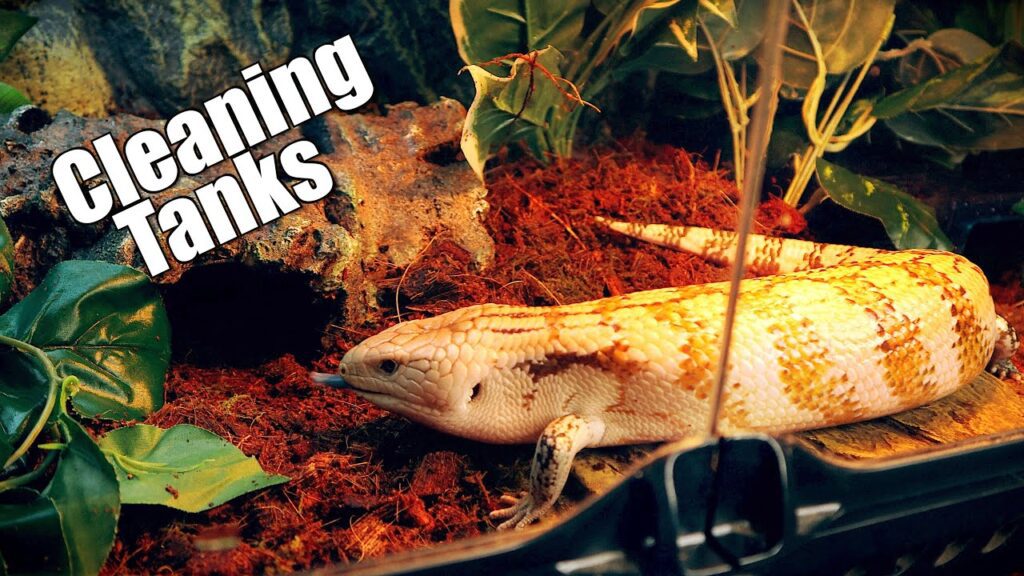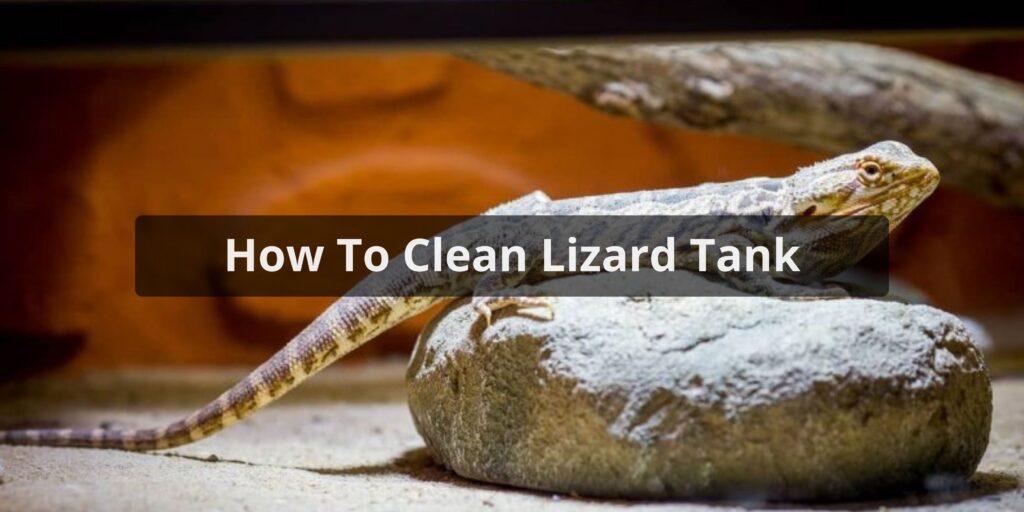Cleaning a lizard tank regularly is essential for maintaining your pet’s health and happiness. While it may seem daunting at first, with the right supplies and techniques, keeping your lizard’s terrarium clean can become a quick and easy routine. In this article, we’ll walk through the step-by-step process of effectively cleaning a lizard tank.
Supplies Needed
Before getting started, you’ll want to gather the necessary cleaning supplies:
- Mild soap or detergent
- Water dechlorinator
- Unscented baby wipes or paper towels
- Disinfectant (reptile-safe)
- Extra bedding or substrate
- Clean tanks, hides, and accessories
Make sure to have dedicated supplies for cleaning the reptile terrarium, separate from other household cleaners which may be toxic to reptiles. A good disinfectant and dechlorinator specifically made for reptiles can help ensure a safe environment after cleaning the tank.
Removing Your Lizard
The first step is always to remove your lizard from the tank. Place them in a secure temporary enclosure like a plastic bin or carrier during the cleaning process. This keeps them out of the way and prevents any risk of escape.
Provide a hide, water bowl, and any lighting or heating elements your lizard requires while housed temporarily. Limit stress by keeping the temporary enclosure in the same general area the main tank is in.
Never clean the tank with your lizard still inside, as many cleaning agents and the cleaning process itself can be harmful.
Taking Everything Out of the Tank
Once your pet is safely out of the way, take everything out of the tank. Remove hides, branches, rocks, bowls, and any other decor. Discard old substrate and bedding.
Having an empty tank makes it much easier to fully clean the glass and all surfaces. Place decor pieces in a separate container to disinfect later.
Cleaning the Tank

With an empty tank, now the real scrubbing can begin! Here are the steps for cleaning the glass and surfaces:
- Pour out old water and rinse away any debris.
- Apply the mild soap/detergent and scrub all glass surfaces.
- Thoroughly rinse the soap away with hot water.
- Use the reptile disinfectant spray or wipes on all surfaces.
- Allow the disinfectant to sit for 5-10 minutes before one final rinse.
- Dry the tank completely with a clean towel.
Make sure to clean the screen lid, external fixtures like lights or domes, and any background wallpaper or materials. Get into all the corners and crevices.
For water bowls or pools, use hot water and soap followed by a disinfectant soak before rinsing.
Cleaning Decor and Accessories
While the tank dries, move on to cleaning the decor. Here are some tips:
- For plastic items: Disinfect with wipes or reuse the disinfectant spray. Let sit 5 minutes before rinsing.
- For rocks and branches: Scrub with soap in hot water, rinse, then disinfect.
- For substrate: Discard old substrate. Clean any washable substrate for reuse. Open new bags as needed.
- For artificial plants: Spray down with disinfectant and allow to sit before rinsing.
Let all items dry fully before placing them back into a clean tank.
Refilling the Habitat
Once the tank and all decor are dry, you can start setting up your lizard’s home again.
- Add 2-3 inches of fresh substrate, smoothing it out evenly.
- Arrange cleaned decor: hides, branches, rocks, and plants.
- Fill water pools and dishes with dechlorinated water.
- Install any lighting and heating elements if needed.
- Double check temperatures and humidity.
The tank should look welcoming, natural, and clean before moving your pet lizard back in.
Returning Your Lizard
The final step is moving your lizard back into their freshly cleaned home. Go slowly and allow them to explore. Watch to ensure they are acting normally, feeding, and adjusting well in the days after a deep clean.
Expect some initial digging or burrowing as they get comfortable again. Schedule the next full substrate change and tank disinfection in 2-3 months.
Performing Spot Cleanings
Between deep cleanings every few months, you should also perform spot cleanings of the habitat about once a week. This maintenance helps control odors and waste between tank disinfecting sessions.
For a spot clean:
- Scoop out soiled substrate daily.
- Use wipes or paper towel to clean waste off decor.
- Check and change water as needed
- Disinfect and scrub water bowls as needed.
- Replace substrates if heavily soiled.
Spot cleaning prevents complete bioactive teardowns and excessive stress on your pet. With regular maintenance, deep cleanings are quicker and easier.
Key Takeaways
Cleaning a lizard’s tank thoroughly but safely takes some specific supplies and techniques. Follow these steps:
- Remove your lizard to a secure temporary container.
- Take out all decor and discard old substrate.
- Wash, disinfect, and thoroughly rinse the tank and all accessories.
- Allow everything to dry fully before reassembling a clean habitat.
- Return your lizard to the cleaned home and monitor them closely
- Spot clean between deep cleanings to control waste and odors.
Set reminders and establish a regular cleaning routine for your lizard’s health and happiness. With the right process, you can keep your pet’s terrarium fresh for their enjoyment. Maintain a clean tank and your lizard will thrive!
Conclusion
Regularly disinfecting and cleaning a lizard’s entire tank is essential for their health. By following safe processes and using proper reptile-safe products, you can completely refresh their terrarium environment. Ensure your pet lizard continues to do well by keeping their home clean. With the right schedule and tank cleaning technique, you can provide the best habitat possible.
FAQs About How to Clean a Lizard Tank
What supplies do I need to clean a lizard tank effectively?
You’ll need: gloves, cleaning solution (vinegar-water mix), scrub brush, paper towels, and a bucket. Ensure the lizard is temporarily in a safe enclosure. Having spare hides and substrates is also useful.
Can I clean a lizard tank without removing the lizard?
Yes, if you have a larger tank, you can clean one side while the lizard is on the other. However, it’s safer to move the lizard to a temporary enclosure to prevent stress or injury during cleaning.
Are there specific cleaning products safe for lizard tanks?
Yes, mild cleaning solutions like a vinegar-water mix (1:1) are safe. Avoid chemical cleaners, as lizards are sensitive to fumes. Rinse thoroughly to remove any cleaning residue before reintroducing the lizard.
How should I clean the substrate and decorations in the tank?
Remove substrate and decorations, wash with water, and scrub gently if needed. Allow them to dry completely before adding them back. Boiling or baking under sunlight can help disinfect items, but ensure they are lizard-safe afterward.
What precautions should I take to ensure the lizard’s safety during cleaning?
Move the lizard to a secure temporary enclosure with hides, water, and appropriate temperature. Minimize stress by handling gently. Avoid sudden movements or loud noises. Keep the lizard away from cleaning solutions and ensure the tank is well-ventilated before reintroduction.
Is it necessary to disinfect the tank during cleaning?
Disinfection isn’t always necessary, but it’s recommended periodically, especially if the lizard has been sick. Boiling water or baking under sunlight can help sanitize substrates and decorations. Ensure items are completely cool and dry before placing them back in the tank.



